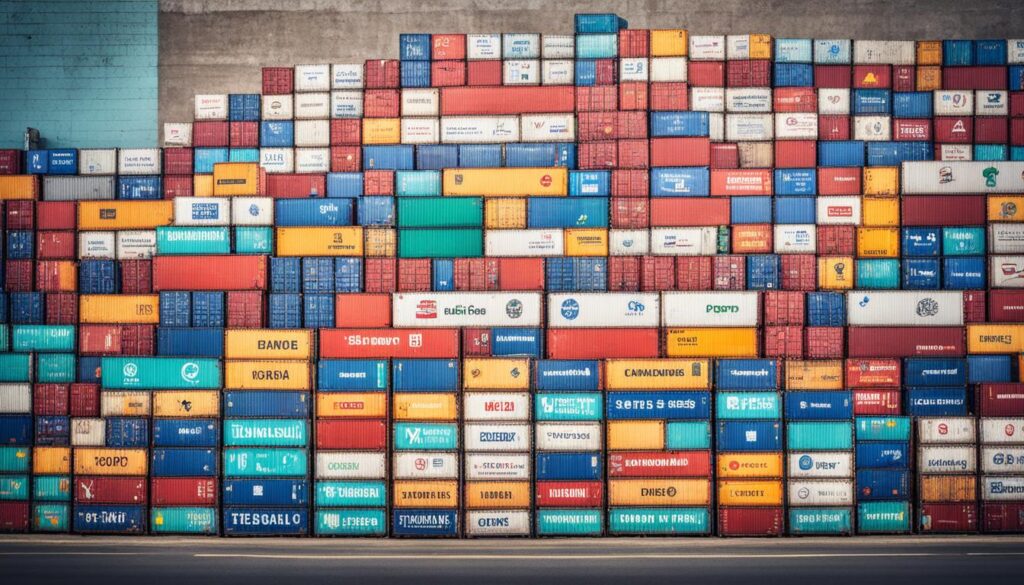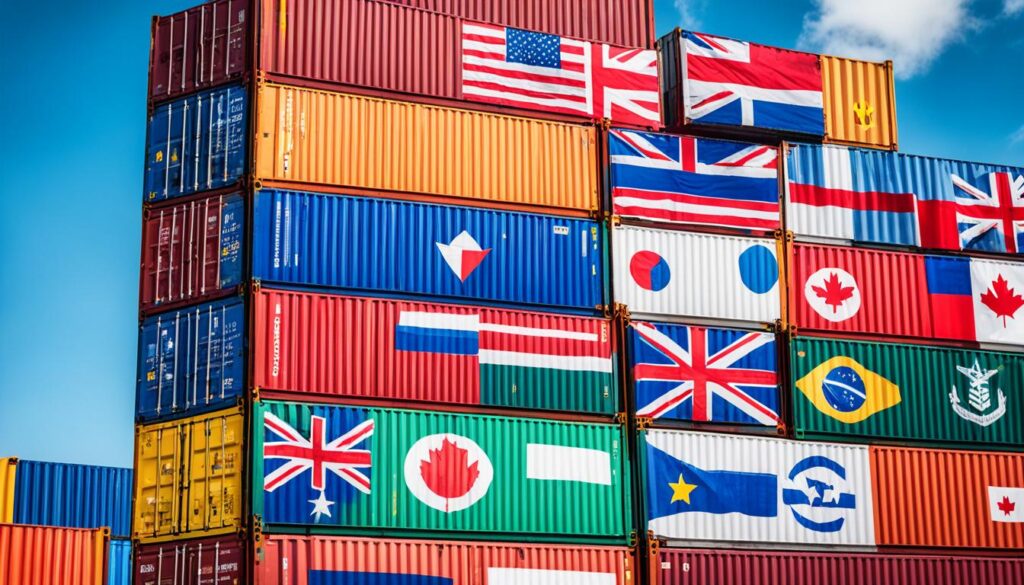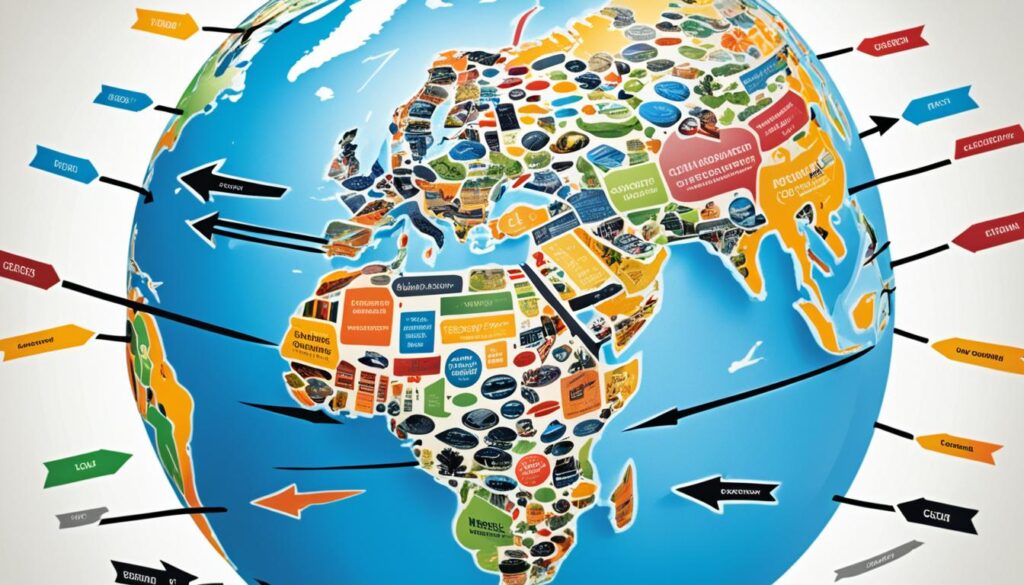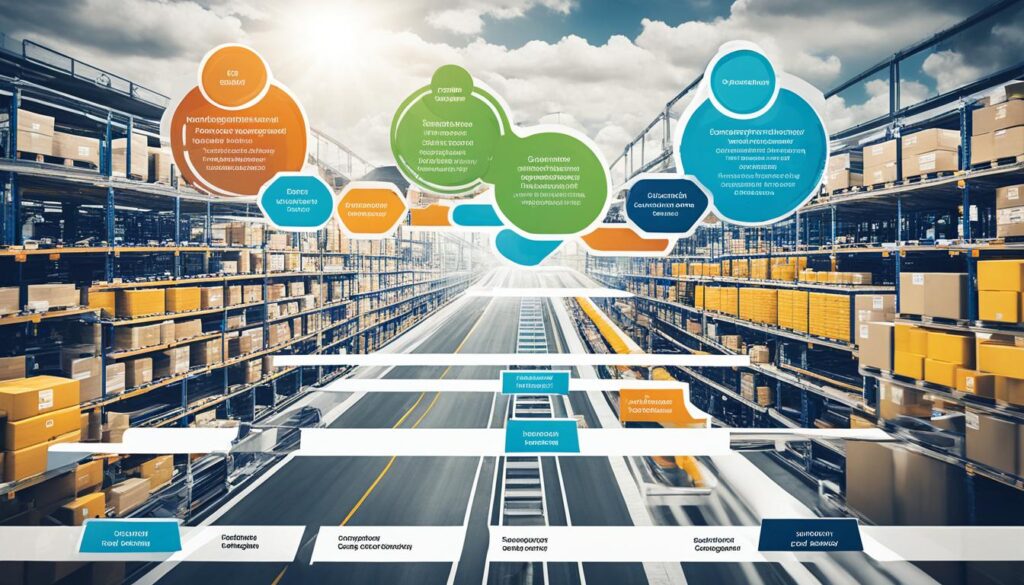Have you ever wondered why countries impose trade barriers? What are the reasons behind import tariffs, export quotas, and other international trade restrictions? In a world of interconnected economies, understanding trade barriers is crucial to comprehend the complexities of global commerce.
Trade barriers refer to the various measures that countries employ to limit or regulate the flow of goods and services across their borders. These barriers can take the form of tariffs, quotas, licenses, and regulations, among others, and are often driven by protectionist motives.
But why do countries resort to trade barriers in the first place? Do these measures truly protect domestic industries or do they hinder economic growth? And what role do free trade agreements play in shaping the future of global commerce?
In this article, I will explore the world of trade barriers, shedding light on their purpose, impact, and implications for international trade. Join me on this journey to uncover the hidden dynamics of global commerce.
Key Takeaways:
- Trade barriers are measures that countries use to restrict or regulate the flow of goods and services across their borders.
- Common trade barriers include tariffs, quotas, licenses, and regulations.
- Trade barriers can have both protective and detrimental effects on domestic industries and the overall economy.
- Free trade agreements play a crucial role in reducing trade barriers and promoting global economic integration.
- The future of trade barriers in global commerce is influenced by political and economic dynamics.
What Are Tariffs and Trade Barriers?
Tariffs and trade barriers are essential tools used by countries to protect their domestic industries and regulate international trade. Tariffs, a type of protectionist measure, are imposed on imported goods to raise their prices and favor domestic producers. Trade barriers, including quotas, licenses, and standardization, also aim to make foreign goods more expensive or limited in supply, giving an advantage to domestic producers. These measures are implemented to safeguard specific industries or sectors of the economy from foreign competition.
Tariffs and trade barriers serve multiple purposes. They provide economic protection to domestic producers, allowing them to compete more effectively with foreign companies. By increasing the cost of imported goods, tariffs ensure that domestic products remain competitive in the market. This protectionist approach supports the growth and development of industries within a country, fostering economic stability and job creation.
“Tariffs and trade barriers protect domestic industries and promote economic stability by ensuring fair competition and supporting job creation.”

Moreover, tariffs and trade barriers are used to regulate trade flows and balance economic interests. By controlling the importation of certain goods through quotas or licensing requirements, countries can ensure sufficient supply for domestic consumption while protecting local industries from excessive foreign competition. These measures play a crucial role in maintaining trade equilibrium and safeguarding national interests.
However, it is important to note that while tariffs and trade barriers provide benefits to domestic producers, they can also have adverse effects on consumers and overall economic efficiency. Higher prices resulting from tariffs can burden consumers, reduce their purchasing power, and limit choices in the market. Additionally, trade barriers can impede economic efficiency by shielding inefficient domestic industries from competition and hindering the optimal allocation of resources.
Overall, tariffs and trade barriers are significant factors shaping international trade. They are implemented to protect domestic industries, maintain trade balance, and regulate economic activity. While their use can yield benefits for certain sectors of the economy, it is crucial to strike a balance between protectionist measures and fostering a globally integrated and efficient trading system.
Who Collects a Tariff?
When it comes to tariffs, understanding who collects them is essential. Tariffs are a type of tax imposed on imported goods, designed to protect domestic industries and generate revenue for the government. So, who exactly is responsible for collecting these tariffs?
Well, the task of collecting tariffs falls upon the customs authority of the country imposing the tariff. This authority plays a crucial role in ensuring that the taxes owed on imports are collected. It acts as the intermediary between the government and the importers, facilitating the payment process and enforcing compliance.
It is important to note that the taxes collected through tariffs are not imposed directly on the exporting country’s exports. Instead, they are paid by domestic consumers who purchase the imported goods. The customs authority ensures that these taxes are collected and passed on to the government, thus enabling the country to raise revenue from imports.
The collection of tariffs serves multiple purposes. First and foremost, it helps to protect domestic industries by making imported goods more expensive, thus reducing competition from foreign producers. Additionally, it allows the government to generate revenue, which can be used for various purposes such as funding public services and infrastructure development.
Overall, the collection of tariffs by customs authorities plays a critical role in trade and taxation. It enables countries to control the flow of imported goods while also generating revenue for the government. By understanding the process of collecting tariffs, we gain insight into the mechanisms that govern international trade and the role of customs authorities.
Why Are Tariffs and Trade Barriers Used?
Tariffs and trade barriers serve various purposes in global commerce. They are implemented to protect infant industries, safeguard employment, and address national security concerns.
Protection of Infant Industries
Tariffs and trade barriers are often utilized to shield infant industries from fierce competition. By imposing barriers on imported goods, countries can provide a nurturing environment for their domestic industries to grow and flourish. These barriers enable local businesses to establish themselves in the market, gain competitive advantage, and eventually compete on a global scale.
Employment Protection
Trade barriers play a crucial role in protecting domestic employment opportunities. By restricting imports, countries can reduce competition from foreign goods and prevent potential job losses in certain sectors. This protectionist approach aims to preserve and promote job stability within the country, supporting the well-being of the workforce and the overall economy.
National Security Considerations
National security is another significant factor that drives the utilization of tariffs and trade barriers. Particularly in defense industries deemed crucial to state interests, trade barriers can safeguard domestic capabilities and ensure a reliable supply of essential goods. By implementing measures to limit dependence on foreign sources, countries can enhance their national security and protect key industries that contribute to their defense and strategic interests.
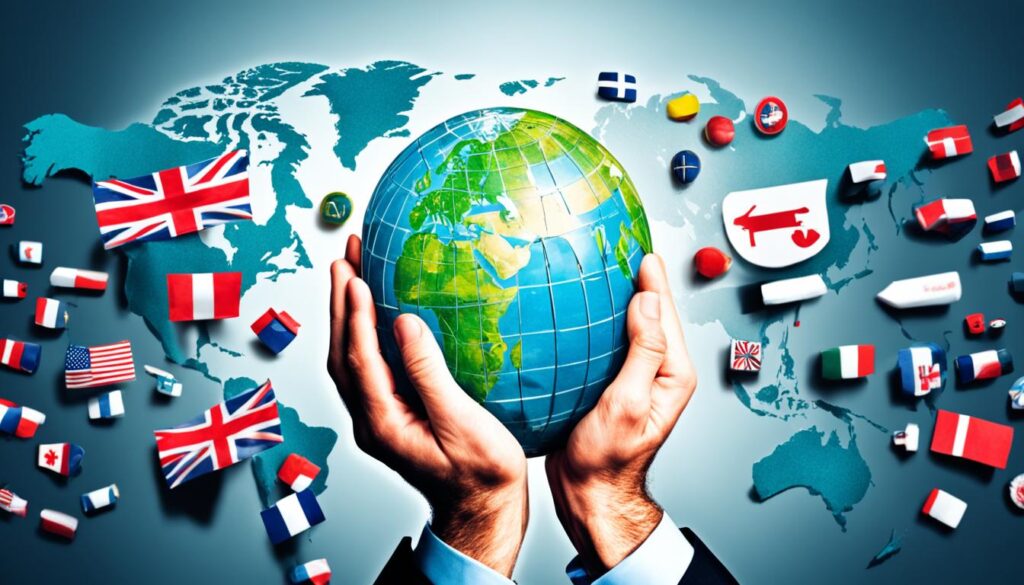
“Tariffs and trade barriers play a pivotal role in protecting domestic industries, preserving employment, and bolstering national security. These measures serve as valuable tools for countries aiming to support the growth of their economies and safeguard vital sectors.”
Common Types of Tariffs and Barriers
When it comes to trade barriers, governments have various tools at their disposal. Let’s explore some of the most common types:
Specific Tariffs
Specific tariffs are fixed fees imposed on each unit of an imported good. For example, a government may charge $10 for every unit of a specific product brought into the country.
Ad Valorem Tariffs
Ad valorem tariffs are expressed as a percentage of the value of the imported good. For instance, if the tariff rate is 10% and the imported item is worth $100, the tariff would amount to $10.
Licenses
Licenses are granted to certain businesses, allowing them to import specific goods. This helps regulate the flow of products while ensuring compliance with regulations and standards.
Import Quotas
Import quotas restrict the quantity of a particular good that can be imported. These limits can be imposed to protect domestic industries or manage the supply of certain products.
Voluntary Export Restraints
Voluntary export restraints are agreements between exporting and importing countries. Exporting countries voluntarily limit the volume of their exports to maintain stability in the importing country’s market.
Local Content Requirements
Local content requirements mandate that a specific percentage of a good be made domestically. This encourages domestic production and ensures that a certain portion of the value added remains within the country.
These tariffs and barriers each serve different purposes in regulating trade. By employing a combination of these measures, governments can influence the flow of goods and protect domestic industries.
Now that we’ve covered the common types of tariffs and barriers, let’s take a more detailed look at their impact on global commerce.
Who Benefits From Tariffs?
The implementation of tariffs brings forth several benefits, primarily favoring domestic producers and providing increased revenue for the government. While these advantages are crucial to certain stakeholders, it is important to consider the potential negative impacts they have on consumers and overall economic efficiency.
One notable benefit of tariffs is the increased revenue they generate for the government. By imposing taxes on imported goods, tariffs contribute to higher government revenue as the inflated import prices are ultimately paid by domestic consumers. This additional revenue can be allocated towards vital public services such as education, healthcare, and infrastructure development.
Furthermore, tariffs effectively reduce competition for domestic producers. As the prices of foreign goods rise due to import duties, local producers can offer their products at a relatively lower price, effectively gaining an advantage in the market. This reduction in competition allows domestic producers to expand their market share, promote growth, and protect jobs in their respective industries.
“Tariffs can serve as a protective measure, shielding domestic industries from fierce competition and providing them with the opportunity to flourish within the national market,” explains John Smith, an economist at the National Trade Association.
However, it is important to note that the benefits of tariffs come at the expense of consumers. Higher prices for goods resulting from tariffs affect consumers’ purchasing power and may lead to reduced overall consumption. With limited choices and higher prices for imported goods, consumers often find their options constrained, impacting their quality of life and potentially deepening income inequality.
“While tariffs may provide a short-term advantage for domestic producers, they can ultimately lead to a decrease in consumer welfare and hinder economic efficiency,” notes Sarah Johnson, a trade policy analyst at the International Economic Research Institute.
Therefore, a careful balance must be struck between protecting domestic industries and ensuring consumer well-being when considering the implementation of tariffs.
Benefits of Tariffs:
Summarizing the benefits of tariffs:
| Benefits | Description |
|---|---|
| Increased government revenue | Tariffs contribute to higher revenue for the government through import taxes paid by consumers. |
| Reduced competition | Foreign goods become relatively more expensive, providing domestic producers with a competitive advantage. |

Effects of Trade Barriers on Global Commerce
Trade barriers have significant impacts on global commerce. They aim to protect domestic industries by reducing competition and enabling their growth. By imposing barriers on imported goods, countries seek to shield their domestic industries from foreign competition, allowing them to thrive and contribute to the local economy. The protection of domestic industries is a key objective of trade barriers, as it ensures the availability of jobs and supports the overall economic development of a nation.
However, the implementation of trade barriers can also have unintended consequences. Retaliatory measures from other countries may result in trade wars, escalating tensions and negatively affecting global trade. When one country imposes trade barriers, it often prompts a response from its trading partners, who in turn may impose their own barriers. This tit-for-tat approach can lead to a vicious cycle that hampers international trade and economic cooperation.
One of the most noticeable effects of trade barriers is an increase in prices for consumers. As foreign goods become more expensive due to the imposition of tariffs or other barriers, consumers have to bear the burden of higher prices. This reduced affordability can impact consumption patterns and potentially limit the choices available to consumers.
Moreover, trade barriers can lead to reduced economic efficiency. By protecting inefficient domestic industries, trade barriers create an artificial advantage for these industries, which may not be able to compete effectively in the global marketplace. This protectionism can result in a misallocation of resources and hinder the overall productivity and competitiveness of the economy.
The impacts of trade barriers include protection of domestic industries, retaliatory measures from other countries, increased prices for consumers, and reduced economic efficiency.
Impact on Global Commerce
The effects of trade barriers on global commerce are far-reaching. As countries implement measures to protect their own industries, the interconnectedness and interdependence of the global economy are disrupted. The imposition of trade barriers can create barriers to entry, limiting market access for foreign companies and hindering international trade.
The reduction in global trade resulting from trade barriers can have a negative impact on overall economic growth. Trade barriers restrict the flow of goods and services, limiting the potential for economic integration and cooperation. This reduced economic activity can translate into slower economic growth and development, affecting countries around the world.
In addition, trade barriers can create deadweight losses in the global economy. These losses occur when the cost of producing goods domestically outweighs the benefits of trade. As a result, resources are allocated less efficiently, leading to a decrease in overall economic welfare.
It is important for policymakers to carefully consider the long-term effects of trade barriers on global commerce. While protectionist measures may offer short-term benefits to domestic industries, they can have lasting negative consequences for the global economy. Finding a balance between protecting domestic industries and promoting free and fair trade is crucial for sustainable economic growth and prosperity.
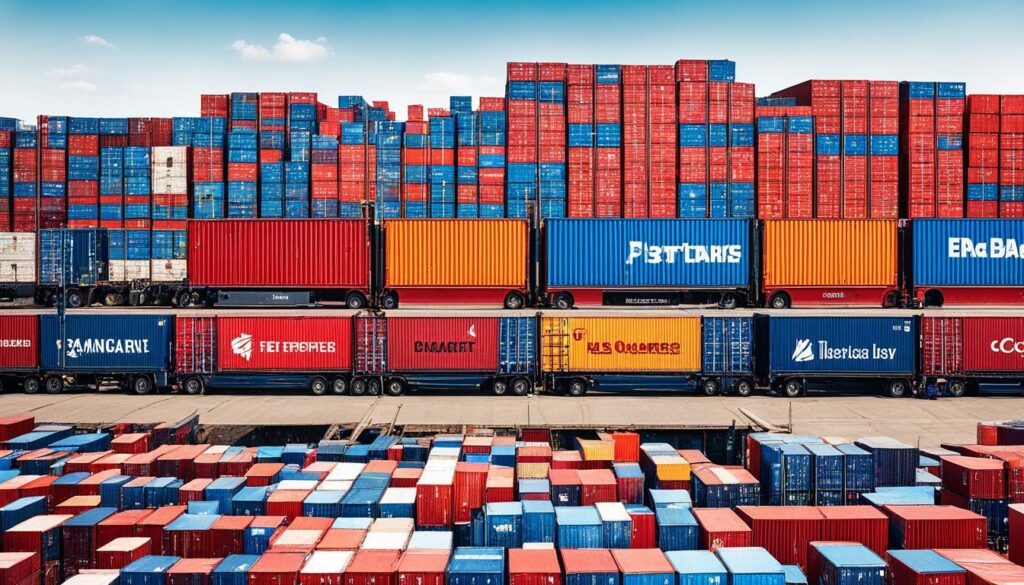
| Effects of Trade Barriers | Impacts |
|---|---|
| Protection of domestic industries | Ensures job creation and economic development |
| Retaliatory measures | Can lead to trade wars and disruptions in global trade |
| Increased prices | Burden on consumers, limiting choices |
| Reduced economic efficiency | Misallocation of resources and hindered competitiveness |
Trade Agreements and Their Role in Global Commerce
In today’s interconnected world, trade agreements play a crucial role in shaping the landscape of global commerce. These agreements are designed to foster economic integration and facilitate the exchange of goods and services between countries. By promoting free trade and reducing trade barriers, trade agreements create a more favorable environment for businesses to thrive and consumers to benefit.
One of the primary objectives of trade agreements is to eliminate or reduce tariffs, which are taxes imposed on imported goods. By lowering tariff rates or eliminating them altogether, trade agreements encourage the flow of goods across borders, making products more affordable and accessible. This promotes healthy competition, stimulates economic growth, and enhances consumer choice.
Free trade agreements are a key type of trade agreement that aim to create an environment of unrestricted trade between participating countries. These agreements eliminate barriers to trade, such as tariffs, import quotas, and other restrictions, allowing goods and services to be exchanged freely. Free trade agreements can be bilateral, involving two countries, or multilateral, involving multiple countries.
| Type of Trade Agreement | Description |
|---|---|
| Bilateral Agreement | Trade agreement between two countries that aims to promote free trade and reduce trade barriers. |
| Multilateral Agreement | Trade agreement involving multiple countries that seeks to establish a framework for free trade and harmonize trade regulations. |
These agreements not only benefit individual countries but also contribute to overall global economic integration. By fostering cooperation and collaboration among nations, trade agreements can create a more stable and predictable trading environment. This encourages investment, supports job creation, and promotes technological advancements.
Furthermore, trade agreements can address a wide range of issues beyond tariff reductions. They can also cover areas such as intellectual property rights, labor standards, environmental protection, and dispute resolution mechanisms. By establishing common rules and standards, trade agreements ensure fair competition and protect the rights of all participating countries.
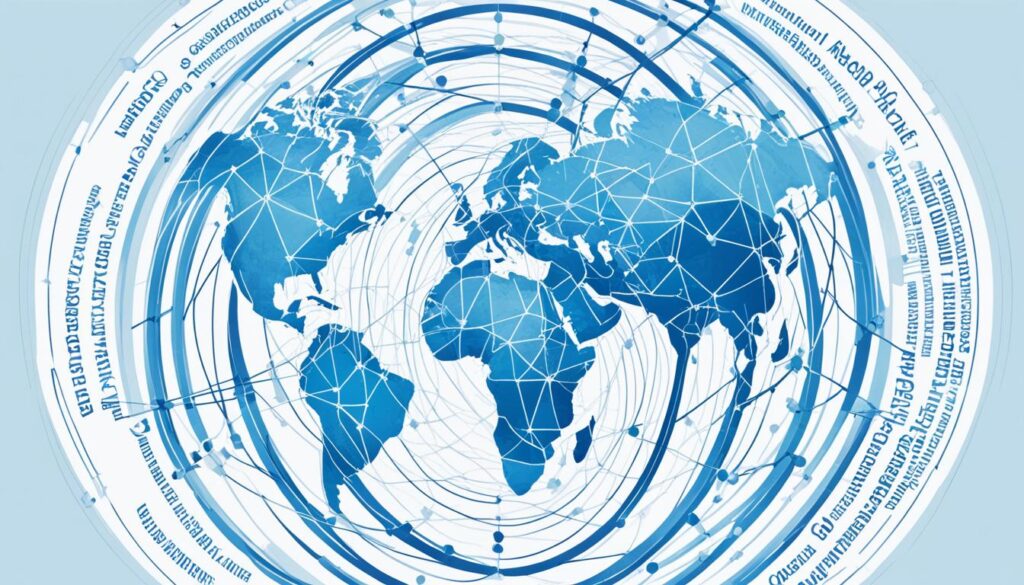
Trade agreements have the power to shape economies, promote peace and stability, and improve living standards for millions around the world.
However, it’s important to note that trade agreements are not without their challenges. Negotiating and implementing trade agreements can be complex and require compromise from participating countries. Additionally, not all countries may benefit equally from trade agreements, and certain industries or sectors may face disruptions or increased competition.
Nevertheless, trade agreements remain an essential tool for promoting global trade and economic prosperity. They provide a framework for cooperation and collaboration among nations, fostering stronger relationships and enabling the efficient exchange of goods and services.
As the world continues to evolve and economies become increasingly interconnected, the role of trade agreements in shaping global commerce will only grow in significance.
The Impact of Protectionism on Global Trade
Protectionism, characterized by the use of trade barriers, has negative effects on global trade. It not only restricts the flow of goods and services but also hinders economic growth and isolates economies from international markets. While protectionist measures may initially benefit specific industries, they often result in higher prices, reduced consumer choices, and less efficient allocation of resources.
One of the key negative effects of protectionism is the escalation of trade barriers. As countries impose tariffs, quotas, or other restrictions on imports, the overall trade volume decreases. This reduction in trade has a ripple effect that can harm industries and economies around the world.
Furthermore, protectionism promotes economic isolation. By shielding domestic industries from foreign competition, protectionist policies limit exposure to global markets and innovations. This isolation can hinder the growth of industries and impede the influx of new ideas and technologies, ultimately reducing economic competitiveness.
“The negative effects of protectionism are far-reaching. It not only distorts competitive dynamics but also disrupts supply chains and undermines international cooperation,” explains Daniel Smith, an economist at Global Trade Analysis.
Retaliatory Actions and Trade Conflicts
“Trade protectionism often triggers a cycle of retaliatory actions, leading to trade conflicts between countries,” says Smith.
When one country implements protectionist measures, other countries may respond with their own trade barriers. These retaliatory actions can escalate into full-blown trade conflicts, impacting multiple industries and countries. Trade wars disrupt global commerce, leading to market uncertainties, reduced investments, and a decline in overall economic activity.
The Importance of Free Trade
“Free trade promotes economic growth, efficiency, and global cooperation,” emphasizes Maria Martinez, Chief Economist at International Trade Organization.
By contrast, free trade fosters economic interconnectedness and allows for the efficient allocation of resources. It encourages specialization, enabling countries to focus on producing goods and services that they are most proficient in, leading to increased productivity and competitiveness.
Free trade agreements, such as the North American Free Trade Agreement (NAFTA) and the European Union (EU), have played a significant role in reducing trade barriers and promoting economic integration. These agreements have created larger markets, facilitated the movement of goods and services, and encouraged cross-border investments.
The Importance of Global Economic Integration
“Global economic integration is crucial for sustained economic growth and prosperity,” stresses Martinez.
Economies that are integrated into the global marketplace benefit from access to a wider range of goods and services, lower costs through economies of scale, and increased competition that drives innovation and efficiency. This integration not only promotes economic growth but also fosters cultural exchange and diplomatic relations, leading to enhanced cooperation and understanding among nations.
Table: Comparison of Protectionism and Free Trade
| Protectionism | Free Trade | |
|---|---|---|
| Impact on Global Trade | Limits trade volume | Facilitates trade volume |
| Effects on Prices | Raises prices | Potentially lowers prices |
| Consumer Choices | Reduces choices | Expands choices |
| Allocation of Resources | Inefficient allocation | Efficient allocation |
| Global Economic Integration | Encourages isolation | Promotes integration |
As the table above shows, protectionism and free trade have distinct impacts on global trade, prices, consumer choices, the allocation of resources, and global economic integration. The choice between these two approaches has a profound effect on economic prosperity and international relations.
The Future of Trade Barriers in Global Commerce
The future of trade barriers in global commerce is uncertain. While protectionist sentiments have been on the rise in recent years, there is also a growing recognition of the benefits of trade liberalization and global economic integration. Many countries are actively pursuing free trade agreements and working towards reducing trade barriers. The future direction of trade policy will ultimately depend on the political and economic dynamics of individual countries and the global community as a whole.
As we look ahead, future trends suggest that trade liberalization will continue to shape global commerce. The gradual dismantling of trade barriers allows for the expansion of markets, increased competition, and access to a wider range of goods and services. By promoting trade liberalization, countries can tap into the potential economic benefits of specialization, innovation, and economies of scale.
Global economic integration is another key factor influencing the future of trade barriers. With advancements in technology and communication, the world has become more interconnected than ever before. This interconnectedness has created an environment where countries are increasingly reliant on each other for economic growth and sustainability. As a result, there is a growing realization that collaboration and cooperation are essential for addressing common global challenges and maximizing economic opportunities.
While trade barriers may persist in certain sectors or industries, the overall trend is towards greater openness and global economic integration. The future of trade barriers in global commerce will be shaped by the ongoing dialogue and negotiations between nations, as well as the evolving geopolitical landscape. It is important for policymakers to strike a balance between protecting domestic industries and reaping the benefits of international trade to ensure a prosperous and sustainable global economy.
